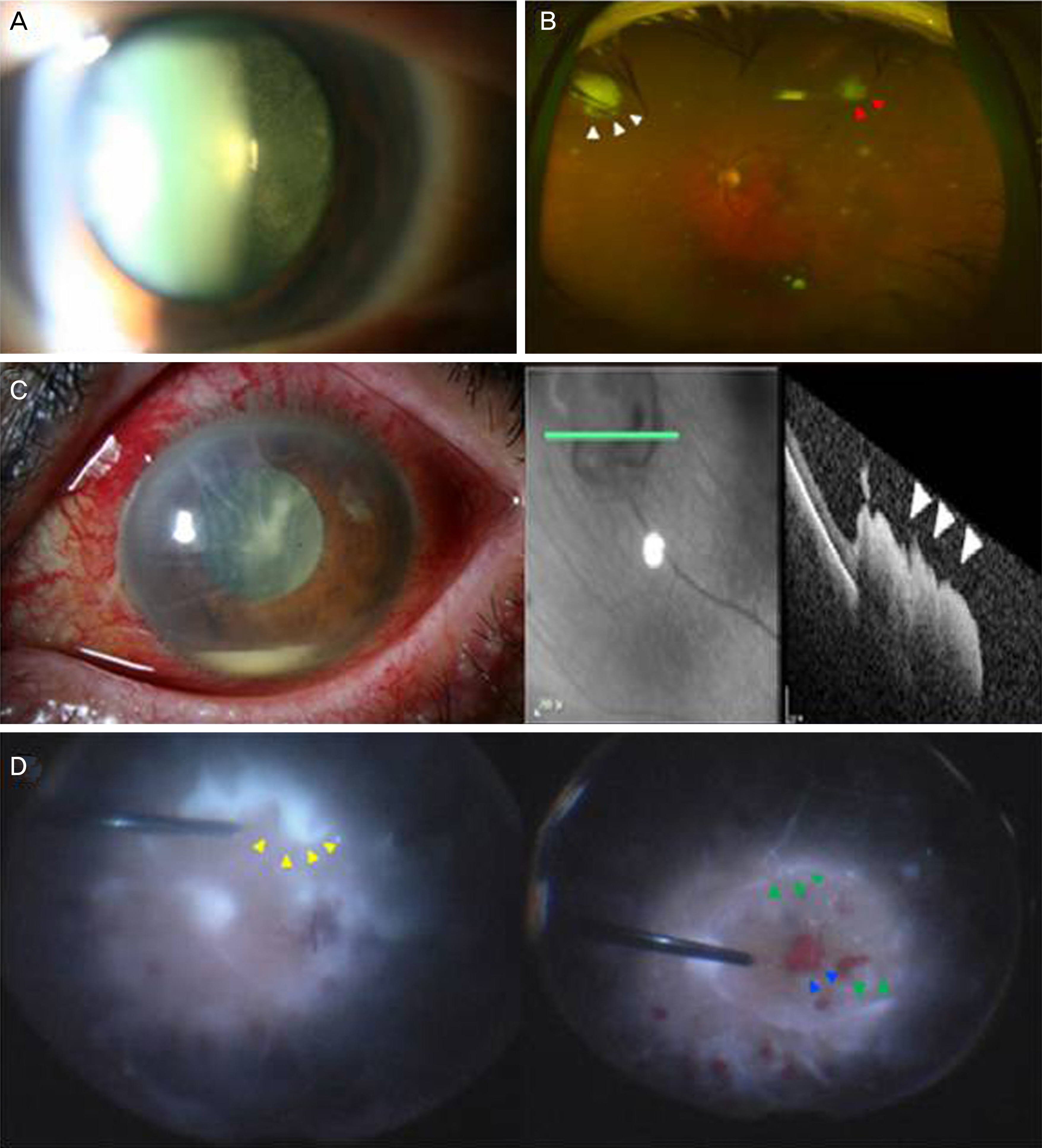J Korean Ophthalmol Soc.
2018 Mar;59(3):282-287. 10.3341/jkos.2018.59.3.282.
A Case of Fungal Endophthalmitis after Having Received Extraction of Wisdom Tooth in Healthy Woman
- Affiliations
-
- 1The Institute of Vision Research, Department of Ophthalmology, Gangnam Severance Hospital, Yonsei University College of Medicine, Seoul, Korea. Minkim76@gmail.com
- 2The Institute of Vision Research, Department of Ophthalmology, Severance Hospital, Yonsei University College of Medicine, Seoul, Korea.
- KMID: 2406964
- DOI: http://doi.org/10.3341/jkos.2018.59.3.282
Abstract
- PURPOSE
To report a case of candida endogenous endophthalmitis in healthy women who had received extraction of wisdom tooth.
CASE SUMMARY
A 65-year-old medically healthy woman who had received extraction of wisdom tooth two weeks ago, presented with floater symptoms in her left eye. Best-corrected visual acuity was 20/40 and intraocular pressure was 17 mmHg in her left eye. Inflammatory cells were found in the anterior chamber and vitreous. Fluorescein angiography showed multiple hypofluorescence without vascular leakage. With provisional diagnosis of intermediate uveitis, she was prescribed oral steroid for two weeks. After that, inflammatory cells in anterior chamber was reduced but vitreous imflammatory cell was increased and fundus examination detected newly developed infiltrated lesion at superotemporal area. The patient was presumed to have fungal endophthalmitis and immediate intravitreal voriconazole injection was performed. Three days after intravitreal voriconazole injection, diagnostic vitrectomy and intravitreal voriconazole injection were performed. Vitreous cultures revealed the growth of Candida albicans. Despite the treatment, inflammatory response in anterior chamber and vitreous rapidly increased and visual acuity was decreased to hand movement. We changed anti-fungal agent, voriconazole to Amphotericin B. Additional three-time intravitreal injection was done and therapeutic vitrectomy with oil injection were performed. After treatment, the patient's fundus markedly improved and inflammatory response was decreased.
CONCLUSIONS
This case report shows candida endophthalmitis in healthy woman who had received extraction of wisdom tooth. So to diagnose endophthalmitis, patient's medical history should carefully be checked including dental care history who presented with vitreous inflammation and inflammatory infiltrated lesion at fundus.
MeSH Terms
Figure
Reference
-
1). Okada AA, Johnson RP, Liles WC, et al. Endogenous bacterial endophthalmitis. Report of a ten-year retrospective study. Ophthalmology. 1994; 101:832–8.2). Liang L, Lin X, Yu A, et al. The clinical analysis of endogenous endophthalmitis. Yan Ke Xue Bao. 2004; 20:144–8.3). Durand ML. Endophthalmitis. Clin Microbiol Infect. 2013; 19:227–34.4). Sridhar J, Flynn HW Jr, Kuriyan AE, et al. Endogenous fungal endophthalmitis: risk factors, clinical features, and treatment outcomes in mold and yeast infections. J Ophthalmic Inflamm Infect. 2013; 3:60.
Article5). Sakata R, Numaga J. Fungal endophthalmitis in an elderly woman: differing responses in each eye. Int Med Case Rep J. 2017; 10:189–92.
Article6). Liu YC, Cheng DL, Lin CL. Klebsiella pneumoniae liver abscess associated with septic endophthalmitis. Arch Intern Med. 1986; 146:1913–6.
Article7). Connell PP, O'Neill EC, Amirul Islam FM, et al. Endogenous endophthalmitis associated with intravenous drug abuse: seven-year experience at a tertiary referral center. Retina. 2010; 30:1721–5.8). Parke DW 2nd, Jones DB, Gentry LO. Endogenous endophthalmitis among patients with candidemia. Ophthalmology. 1982; 89:789–96.
Article9). Samiy N, D'Amico DJ. Endogenous fungal endophthalmitis. Int Ophthalmol Clin. 1996; 36:147–62.
Article10). Ku M, Jung JO, Lee DY, Nam DH. Endogenous Candida endophthalmitis with bilateral massive submacular abscess. J Korean Ophthalmol Soc. 2008; 49:1701–5.
Article11). Sen P, Gopal L, Sen PR. Intravitreal voriconazole for drug-resistant fungal endophthalmitis: case series. Retina. 2006; 26:935–9.
- Full Text Links
- Actions
-
Cited
- CITED
-
- Close
- Share
- Similar articles
-
- Wisdom teeth extraction in a patient with moyamoya disease
- Six Cases of Fungal Exogenous Endophthalmitis after Cataract Surgery
- Complications of impacted third molar extraction: retrospective study
- A Case of Alcaligenes xylosoxidans Endophthalmitis after Cataract Extraction
- Bilateral Staphylococcus Epidermidis Endophthalmitis After Cataract Extraction




